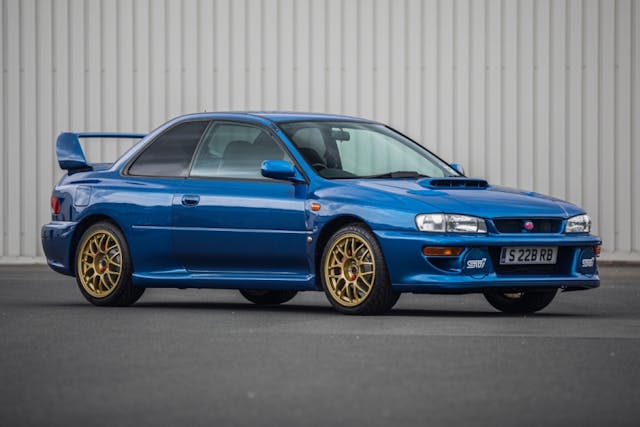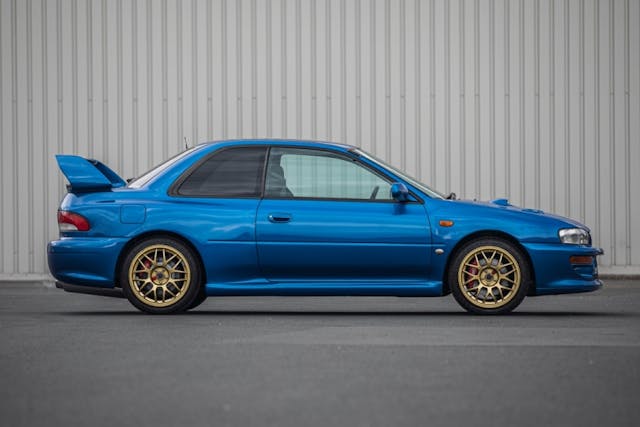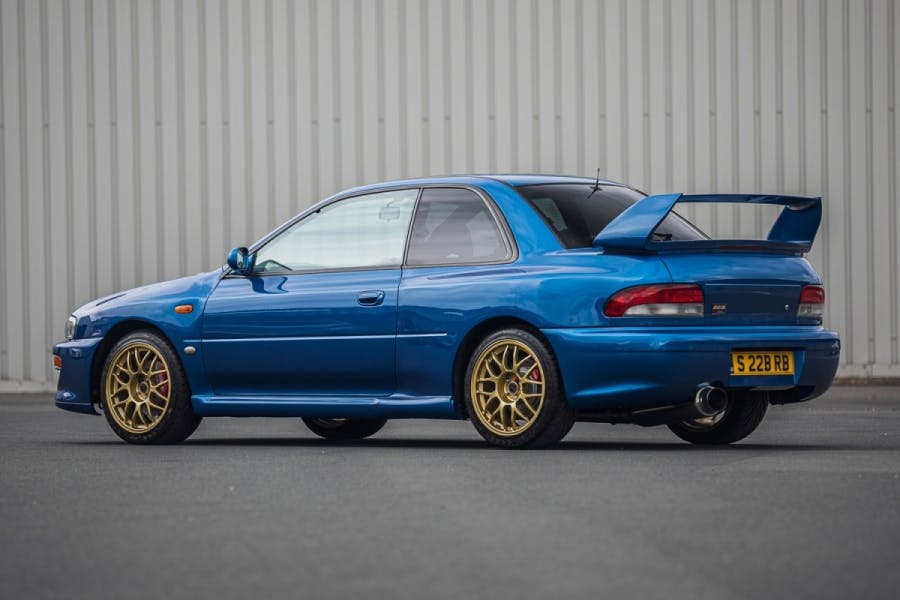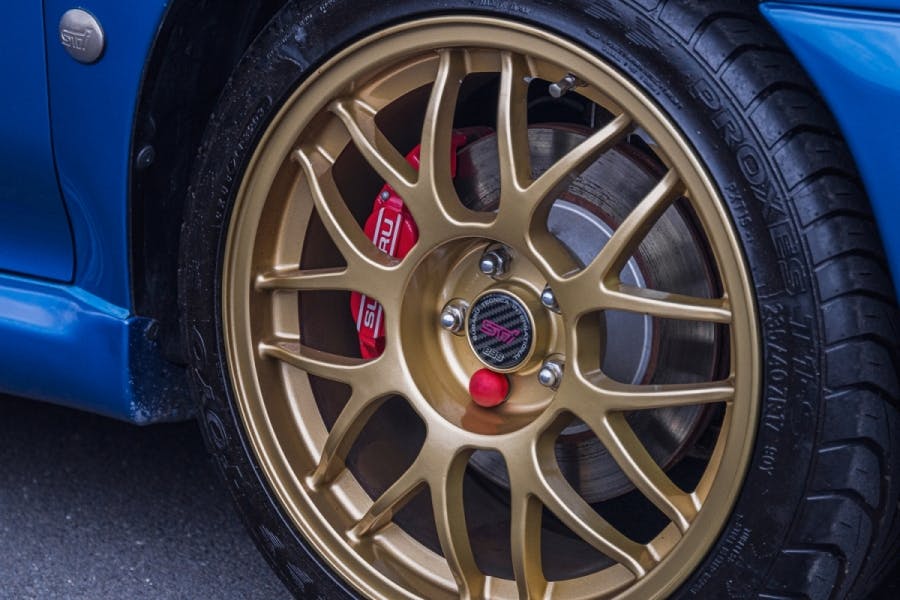Media | Articles
As a Subaru STI 22B heads to U.K. auction, 2023 can’t arrive soon enough

A Subaru 22B STi is finally coming up for auction, a rare event that will have collectors and fans of ’90s Japanese performance paying close attention. For the uninitiated: the 22B is perhaps the most desirable and beloved vehicle in Subaru’s history. In fact, the 22B is so iconic for the seven-star brand that one stole the spotlight from the WRX STi S209 that launched at the 2019 Detroit auto show. Unlike the 341-horsepower STI S209, which is only offered in the U.S. (finally we get the fastest version of a Japanese car) the 22B was a limited-production monster only sold in a few right-hand-drive countries.
Why don’t we see more 22Bs at auction, though?
For one, the cars are very rare. A total of only 424 22Bs were produced—400 for the Japanese market (all of which have a number plate on the center console), an additional 21 for Australia and the U.K. (no number plates), and three prototypes (with number plates reading “000/400”). Another reason they’re seldom up for auction: 22Bs can’t be imported to America, where most live auctions take place, because of the federal 25-year rule.

This 22B offered at the Silverstone Classic online auction at the end of July is #326 of the 400 JDM cars. It was imported to the U.K. in 1998, and overall, the car is in fantastic condition with 30,000 miles on the odometer. It’s been through three owners, the most recent of which owned the car for the last 16 years. Excellent documentation provides information dating back to its initial import. This type of condition is not uncommon for a 22B, considering how collectible they were the minute they were sold new in 1998. Subaru reportedly sold out of all 400 JDM 22Bs in 30 minutes.


Horsepower was rated at 276 from factory, per the Japanese automakers’ “gentleman’s agreement” to not exceed that figure on production cars, but it’s rumored the 22B produced north of 300 horsepower. This 22B has been lightly modified with an upgraded ECU and hand-built exhaust system with a massive tailpipe, resulting in 336 horsepower according to an included dyno sheet.
Marketplace
Buy and sell classics with confidence
The auction house is listing an estimate of £70,000–£80,000 ($88,500–$101,000), but we’re expecting this 22B to sell toward the high end of that range, if not above. In 2016, car #307 sold at Silverstone for £73,125 (roughly $100,000 at the time). Though #307 was a factory stock example with only 2500 miles, it was involved in a crash that required replacement of two body parts but resulted in no structural damage. (The ownership by world featherweight champion “Prince” Naseem Hamed probably made up for any value lost in the crash.)
The 22B, with its wide-body fender flares, massive wing, and striking WRC Blue paint over gold BBS wheels is what a lot of enthusiasts picture when they think Subaru. Although Subaru has become a household name, that wasn’t always the case. In the early 1990s, Subaru accounted for less than 1 percent of total U.S. car sales. Subaru’s market share bottomed out at 0.63 percent in 1995.
As Subaru won three consecutive World Rally Championships from 1995–97, the brand’s market share increased to 1 percent. For 1998, the 22B STi was built to commemorate Subaru’s WRC success. That same year, the American market got the Impreza 2.5 RS—a watered down version of the WRX that provided the base for the 22B. By 2001, when the 2.5 RS finished production, Subaru’s market share continued to grow, and enthusiasm for the 22B and 2.5 RS convinced Subaru to offer the WRX in America. It wasn’t until the WRX STi arrived in 2004 that Subaru sales—driven largely by the Outback and Forester—started to take off. In the 15 years that followed, Subaru’s market share skyrocketed, and the WRX STi became an integral part of America’s enthusiast car culture.

Subaru is especially loved by younger enthusiasts in the U.S., who grew up as fans of Subaru’s WRC success and crazy fast, all-wheel-drive compacts. Using Hagerty insurance quotes as a sign of buying intent, millennials are major drivers of the collector Subaru market, accounting for a staggering 65 percent of the interest in the WRX STi. Gen X follows with 27 percent of STi quotes, while baby boomers show almost no interest at all. The Subaru STi is already considered a classic by younger generations and demand will continue to grow as these buyers age into their car collecting years.
Since the $100,000 22B sale in 2016, modern Japanese performance cars have greatly increased in value. In the May 2016, the value of a Concours (#1-condition) 1997 Toyota Supra Turbo (Mk IV) was only $77,500. Since then, several Mk IV Supras have sold for over $100,000 and the Hagerty Price Guide value has risen 80 percent to $139,000. In fact, the average value for an Excellent (#2-condition) 2004–07 Subaru WRX STi has increased 53 percent in that same stretch of time, from $22,080 to $33,820.
Japanese cars have been on fire in the market and show no signs of slowing down. Now is a tempting time to buy a 22B, especially before these cars begin to become legal for import to the U.S. in March of 2023. Next to the R34 Nissan Skyline GT-R, the 22B is likely the most anticipated car that is for now out of legal reach under the 25-year rule.
I, for one, can’t wait… Anyone need a kidney?






cool car i might by it